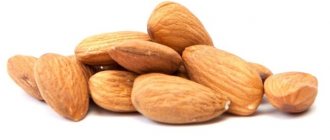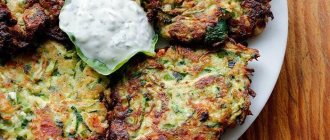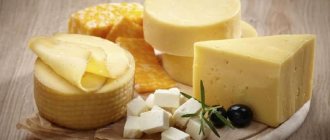The breastfeeding diet limits women's food intake, especially sweets, which often causes early termination of breastfeeding. Many people are interested in whether it is possible to have ice cream while breastfeeding in the first month. Today we will answer this question and figure out what types of ice cream can be used by lactating mothers, how to properly introduce them into the diet and eat them. We will also share healthy ice cream recipes for nursing women.
Store-bought ice cream should not be eaten while breastfeeding; it is much better to make natural ice cream with your own hands.
The benefits of ice cream for breastfeeding
Natural ice cream is a healthy and tasty product that we have loved since childhood. It contains vitamins, minerals and other valuable substances. Ice cream contains amino acids, fatty acids, and mineral salts. Thanks to this composition, the delicacy has the following properties:
- Stimulates the synthesis of the joy hormone, which helps improve mood, overcome stress and depression.
- Improves the functioning of the immune system.
- Strengthens bones and teeth.
- Improves the functioning of the cardiovascular system.
- Speeds up metabolism.
- Improves skin condition.
- Normalize the functioning of the nervous system.
- Gives strength.
- Helps with insomnia.
- Improves the functioning of the reproductive system in women. It has been proven that women who regularly consume ice cream become pregnant 25% more often than those who give it up.
- Normalizes the functioning of the gastrointestinal tract, etc.
How does ice cream affect lactation?
A poor diet negatively affects breast milk production. It is believed that eating ice cream has a beneficial effect on breastfeeding. This is primarily due to the fact that it promotes the synthesis of the joy hormone. A calm and joyful woman is more likely to breastfeed. Endorphins stimulate easier release of breast milk. In addition, the product contains a fairly high fat content, which can affect the fat content and nutritional value of milk. Therefore, if you are looking for sweet treats while breastfeeding, pay attention to this product.
Choosing ice cream during lactation
Russian quality standards set strict requirements for freshness, organoleptic characteristics, and milk protein content. For example, in order for a manufacturer to call its ice cream a sundae, it must contain at least 12% milk fats and be completely free of vegetable fats. So just by the name of the ice cream you can predict what will be inside the package.
An important quality indicator is the organoleptic properties of the product. For vanilla, creamy ice cream and ice cream, we can evaluate them ourselves.
| Indicators | Signs of quality ice cream |
| Taste | Sweet milky without additional flavors. |
| Smell | Milk, for vanilla ice cream – vanilla. Ice cream with foreign odors should not be eaten. Most likely, it was stored or transported together with other food products, which is strictly prohibited and is fraught with intestinal infection. |
| Consistency | Dense, creamy. |
| Structure | Completely homogeneous. There should be no ice crystals, pieces of fat or lactose. The only exception is the small brown particles in natural vanilla ice cream. Ice on the surface of the ice cream indicates that the product has been refrozen. |
| Color | Smooth, milky to creamy. |
The quality of ice cream with additives is more difficult to determine, so you will have to trust the information on the packaging. Unfortunately, domestic manufacturers commit many violations in which eating ice cream for nursing mothers can be dangerous.
What sweets can a nursing mother eat - a list of allowed sweets.
In 2021, Roskachestvo tested 34 popular brands of ice cream. In 2 samples, part of the milk fat was replaced with cheap vegetable fat, and the information on the packaging assured that there was no vegetable fat in the composition. E. coli was also detected - 2 samples, antibiotics - 2 samples. One brand had increased acidity, that is, it was made from milk that had begun to sour.
No violations were detected in only 10 brands of ice cream out of 34.

When and why should you not eat ice cream when breastfeeding a newborn?
The main harmful property of modern ice cream is its composition. There are practically no natural treats on store shelves. It contains emulsifiers, preservatives, stabilizers and other harmful substances. They can harm not only the baby, but also a healthy adult. Manufacturers, in order to save money, often replace natural fats with synthetic ones, which are not digested properly and are deposited in the body. This leads to the development of atherosclerosis and various types of harmful neoplasms.
Ice cream is a sweet and high-calorie product. Excessive consumption affects a woman’s figure, so people who are obese or losing weight need to limit the amount of treats in their diet. A high sugar content negatively affects the condition of tooth enamel. It is not recommended to eat the product if you have atherosclerosis or high blood cholesterol levels. In addition, ice cream is prohibited for people with diabetes. Only special ice cream is allowed where sugar has been replaced with one of the other sweeteners.
Allergy
Ice cream contains allergens. First of all, it is cow protein, which often causes an allergic reaction in infants. High sugar content aggravates the situation, increasing the risk of developing negative reactions. Colored ice creams may contain either dyes or natural additives. They can also cause allergies in your baby. This is why a nursing mother is not recommended to eat fruit or chocolate ice cream.
Lactase deficiency
In addition to allergies, milk protein can cause individual intolerance, which is also known as lactase deficiency. With this disease, dairy products are not digested, which can be manifested by bloating, stool disturbances and other reactions from the gastrointestinal tract. If a child experiences such a reaction when a nursing mother eats ice cream, it is recommended to consult a doctor to rule out lactose intolerance.
How to properly introduce ice cream into a mother’s diet during breastfeeding
A few classic rules must be followed:
- Carefully study the composition of the product, pay attention to the reliability of the manufacturer and the expiration date of the product indicated on the label.
- Monitor the gradual administration in small portions.
- Consume the product immediately after morning feeding, then breast milk will be safer, since harmful substances will already be eliminated from the body, and in the evening the immune system is most susceptible to pathologies.
- Monitor the child’s condition, analyze it, and record details in a food diary every day.
During lactation, you should not deny yourself small pleasures. A small amount of a natural, high-quality product eaten is unlikely to harm the baby, and the gourmet mother will receive satisfaction, which will have a positive impact on the condition of both.
If a child exhibits anxiety, gas, bloating, colic, swelling, or allergic symptoms, you will have to give up chocolate ice cream and replace it with another tasty but safe treat.
Can a nursing mother eat ice cream?
Breastfeeding is not a disease, so strict restrictions vary from person to person. During this time, you are allowed to eat any food. It is important that it is natural. The same goes for ice cream. If it is natural and correctly introduced into the diet, then ice cream will only bring benefits during breastfeeding.
In the first two weeks, first month after birth
Breastfeeding diet is important. It is based on the safest products that will definitely not harm an infant. Even those who do not believe that such nutrition is necessary agree with its necessity in the first weeks after childbirth. This is due to the fact that the baby’s gastrointestinal tract is just adapting to a new type of nutrition, learning to cope with the different components that enter it with breast milk. To make the adaptation as gentle as possible, it is better to avoid foods that can cause allergies or are difficult to digest during this period. Therefore, in the first month after giving birth, eating ice cream, even organic, is not recommended.
What to do if you eat ice cream during breastfeeding?
Not every mother can resist, so women often complain that they still ate a little ice cream. If your baby is older than 5 months, or you know that the child is definitely not allergic to milk protein, then most likely this will not harm the little body.
If you are a mother with allergies, or your baby has recently been born, you need to stop breastfeeding for a while. Food components begin to enter breast milk within 20 minutes after consumption. They can be released for up to 24 hours. Therefore, at this time it is recommended to feed the baby with stored expressed milk or formula. Some experts recommend additional pumping so that “bad” milk does not remain in the breast.
Doctor Komarovsky's opinion
Dr. Komarovsky always advocates comfortable breastfeeding. He believes that a lactating woman does not need to change her diet. A nursing mother can eat any natural products. The same goes for ice cream. According to him, you can eat homemade treats whenever you want, carefully monitoring your baby’s reaction.
What kind of ice cream can you eat while breastfeeding?
The very first rule when choosing ice cream for a nursing mother is the requirement that the product be natural. The treat should not contain flavorings, preservatives or other chemicals. It is best to choose white or cream ice cream. Chocolate or fruit types are not prohibited, but it is not recommended to eat them, as the risk of negative reactions in this case increases.
Dairy based
Dairy-based ice cream is most suitable for nursing mothers. It is allowed to be eaten after 3 months in small quantities. It is important to choose a treat without fillers, condensed milk, nuts, etc. Such additives increase the risk of developing allergies in a child. The most famous representatives of such ice cream are “Ice cream” and “Eskimo”. You can read more about the first one in the article “Is it possible to have a seal while breastfeeding?”
Fruit based
Fruit-based ice cream is more commonly known as frozen ice. It is made from fruit or fruit and berry juice. Such a product will only bring benefits if it does not contain chemical additives. But it is important to remember that most fruits are allergens, so you need to be very careful when eating fruit ice cream during breastfeeding. If you love just these varieties, it is important before tasting to introduce into the diet the fruits and berries that are included in its composition separately and make sure that the baby is not allergic to them.
Shop
It’s rare to find natural ice cream on store shelves. It is important to choose a product responsibly. It is best to buy white ice cream, such as vanilla. It contains the least amount of harmful substances. It is usually sold in a glass. You should not eat store-bought treats too often. Once or twice a week will be enough. Still, it is better for nursing mothers to choose organic homemade ice cream.

If you decide to treat yourself to store-bought ice cream, then choose white vanilla ice cream without additives in a waffle cup.
Pharmacy
Ice cream sold in pharmacies is considered healthier than store-bought ice cream. It contains no harmful additives. It is not a medicine. There are many manufacturers of such delicacies, as well as types of products. You can find hematogenous, spirulina, yoghurt, honey or chocolate treats that will be safe for your baby, except for the risk of allergies. Therefore, carefully read the composition - each component must be introduced into your diet separately before you eat ice cream.
Homemade
Of course, homemade ice cream is the healthiest and safest. You can be confident in the quality and composition of the product. Of course, to prepare it you need to tinker in the kitchen. Usually, preparing sweets does not require much time and skills, so anyone can do it. Start with regular white ice cream, and over time add fruits, nuts and other additives that are present in your menu.
Summarize
Breastfeeding mothers need to carefully follow a diet, and this can be very difficult, because feeding imposes quite serious taboos on numerous foods. Since the food that a nursing woman eats must be protected from harmful substances that can get into the milk, and through it into the baby’s gastrointestinal tract, she should be very, very careful.
All this can have a slight effect on a woman’s mood, so the opportunity to enjoy ice cream should be present in the life of a young mother. If you follow the rules stated above, the opportunity to enjoy ice cream can brighten up long months of dieting, lift your spirits, and inspire you to come up with your own interesting recipes for this cold sweetness. Therefore, do not deny yourself a little joy, just be careful, because the health of your baby depends on you.
- Related Posts
- Is it possible to eat ice cream when you have a sore throat and signs of a sore throat?
- 6 delicious recipes for ice cream for cake
- 2 recipes for chocolate topping for ice cream
From what month can a nursing mother eat ice cream?
Real ice cream is not recommended to be introduced into the diet before the baby is 4 months old. It is best to introduce white first, as it is the safest. It contains milk, sugar, cream. It is recommended to taste fruit types after checking the baby’s reaction to the fruits and berries in the composition. However, it is not recommended to eat such a treat for up to 4 months.
Cream
White natural ice cream has been familiar to us since childhood. It is one of the safest, so it is allowed from 4 months of the baby’s life. Today, many brands produce a delicacy called “Ice cream”. It is important to remember that you still need to read the ingredients, because manufacturers are cunning by adding chemicals to the sweetness for a longer shelf life of the product and reducing its cost.
Read more in the article “Is it possible to have a seal while breastfeeding?”
Creamy soft
Creamy soft ice cream delivers flavor and texture. If it does not contain chemical additives, it is also included in the list of the safest. It should be remembered that the fat content of creamy ice cream is higher than usual. This can cause increased gas formation, colic, or problems with bowel movements in the baby, so do not eat a lot of this treat.
Sorbet or fruit ice
Sorbet or fruit ice is prepared from the juice of fruits and berries. Many of them are quite allergenic, which can harm the baby, so it is not recommended for a nursing mother to eat this type of sweetness. But popsicles are not prohibited. If you already eat some fruit, then ice based on it will only be beneficial. When consuming, it is important to take into account that such ice cream often contains a lot of sugar. This negatively affects the body of a small child. It is best to eat popsicles when your baby is six months old.
Chocolate
Chocolate ice cream is also not included in the list of products for nursing mothers, since chocolate is considered a strong allergen during breastfeeding. But if you or close relatives have never had an allergic reaction to chocolate, you can eat its derivatives while breastfeeding. It is best to introduce this sweetness into the mother’s diet after 6 months.
Pistachio
Pistachios, like other nuts, can cause allergies in your baby. Introduce this ice cream into your diet carefully. It is recommended to try the treat at 4–5 months. First add pistachios to the menu. Only if there is no reaction to them, you can eat ice cream. Also, keep in mind that store-bought pistachio ice cream contains a large amount of sugar and flavorings.
Creme brulee
This ice cream is made with caramel. It has a wonderful taste. A nursing woman is allowed to eat it, because the special taste is provided by sugar caramel, which is not prohibited during breastfeeding. The delicacy is allowed to be eaten 3 months after birth, just like regular white treats. It rarely causes negative reactions in the baby.
Features of introduction into the diet
If, nevertheless, a nursing mother cannot resist the temptation to eat a cold delicacy, she should remember that different types of delicacy differ in their effect on her body and on the condition of the child. It all depends on their composition.
Ice cream for a young mother
Experts do not recommend “Plombir” ice cream to women during breastfeeding due to its high fat content and the high concentration of cow’s milk in it. Excess fats can cause a young mother to gain weight, which is already common during lactation.
A large percentage of cow's milk in the delicacy causes an excess of casein in the baby's body, which will lead to gastrointestinal problems. The calorie content of the product in question is up to 500 kcal, and the fat content is at least 25%.
Considering the high energy capacity of this type of ice cream, doctors allow their patients to include it in their diet only after a year of feeding. In this case, the frequency of administration should be no more than 2 times a week, one serving.
What you need to know about ice cream
This type of delicacy is in second place in terms of fat content after “Ice cream”. This is explained by the fact that the basis of the product is milk cream.
However, this variety is quite high in calories and also contains cow’s milk, which is contraindicated for a baby until his gastrointestinal tract has matured. And for mom, 300 kcal in 100 grams of treats is completely unnecessary.
During breastfeeding, creamy ice cream can be introduced into the diet of a young woman as early as six months after the birth of the child. Like any delicacy, a creamy cold product should not become an everyday food. 2 - 3 times a week will be enough to lift a woman’s mood.
Popsicles while breastfeeding
Experts include sorbet and fruit ice as fruit varieties of this delicacy. The technology for manufacturing the product involves the use of various juices, purees made from fruits, and low-calorie yoghurts. Some recipes allow you to include green tea or instant coffee in this ice cream.
If such delicacies do not add extra pounds to the mother, then they can pose a certain threat to the baby. Almost all products contain caffeine, which is harmful to the child; cocoa beans can cause intestinal disorders, and various fruits can provoke an allergic reaction.
Although pediatricians are convinced that fruit treats are the safest of all types of ice cream during breastfeeding. It is allowed to be introduced into the diet of a nursing woman three months after the birth of the child. True, this should be done under the supervision of a doctor.
Chocolate ice cream and lactation
This variety of sweet product is loved by many women for its unique taste and high tonic properties. But during breastfeeding, this type can be allowed to the mother only after a year of lactation.
This recommendation is due to the fact that the product, in addition to milk and cream, which is already harmful for the baby, may contain chocolate and cocoa beans. These components are prohibited for a young mother as substances that can cause a severe allergic reaction.
In addition, chocolate, when it gets into the baby’s blood, negatively affects the functioning of his central nervous system. Chocolate ice cream during breastfeeding is in no way inferior to “Ice Cream” in its negative impact on mother and child, and in some components it even poses a more serious threat to the health of the entire young family.
Watch the video about nutrition for a nursing mother:
Reviews from those who ate ice cream during breastfeeding
Karina, 34 years old
I've been eating ice cream for probably about a month now. Nothing bothered the baby. I was very glad about this, because the chocolate gave me a rash. And I really wanted something sweet.
Maria, 32 years old
I have been eating homemade ice cream all the time, almost since the maternity hospital. But one time I decided not to bother and bought regular vanilla. That's when the child had green, loose stools. Not nice.
Oksana, 23 years old
I ate ice cream after six months. I cooked it myself from farm products. Exclusively white, of course. It’s not such an important product to eat from the hospital. P.S. The child had no allergies.
Recipe for homemade natural cottage cheese ice cream for a nursing mother
There is nothing healthier than homemade ice cream. If you have a few free minutes, use the following recipe and treat yourself to natural ice cream. If you do not use additives or sweeteners, you can eat this treat from 2-3 months.

Homemade natural cottage cheese ice cream for mothers while breastfeeding.
Compound:
- Cottage cheese - 1 pack.
- Fat sour cream - 4 tbsp. l.
- Jam, sugar, condensed milk or dried fruits - to taste.
Preparation:
- Beat cottage cheese with sour cream.
- Add dried fruit, jam, sugar or condensed milk to taste, based on what foods are already in your diet.
- Place in molds and leave in the freezer overnight.
Recipe for making banana ice cream at home
One of the allowed fruits for nursing mothers is banana. You can eat it from the hospital. Therefore, ice cream based on it will only bring benefits. Like any type of treat, it is not recommended to eat it until 4 months of age when using supplements. If you cook without sugar and vanillin, you can eat sweets from 2-3 months.
Compound:
- Sour cream - 200 g.
- Banana - 2 small.
- Powdered sugar - to taste (or without).
- Vanillin - to taste.
Preparation:
- Beat sugar, vanilla and sour cream until smooth.
- Add chopped and peeled banana to the mixture. Beat with a blender.
- Place the mixture into molds and place in the freezer.











